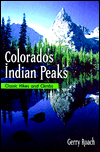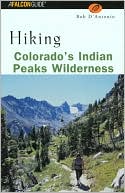



| » | » | » | » |
Sunday morning, August 20th, 2017, Suzy and I drove up for a four day camping trip at the Indians Peaks Wilderness Area with our black lab, Abbey. Abbey is going on ten years old now, and doesn’t have the hips and legs for long hikes anymore, so Suzy wanted to let her play around Brainard Lake, and take a few short hikes, while I spent a couple days attempting some peaks. The next day then, Monday the 21st, it was 5:30 AM when I started out at the Long Lake Trailhead for an attempt on Shoshoni Peak. About 90 minutes up the trail, I had enough light for this shot of some wildflowers on a distant rock outcrop.

At Pawnee Pass, I turned southwest and had scrambled up to Point 12,878 by 9:30 AM, where I took this shot showing the rocky scree slope I needed to cross to reach Shoshoni’s North Slopes. From here to the North Slopes was the worst part of the ascent; although, the scree was more stable than it looked and took only about thirty minutes to cross.

I was on the North Slopes of Shoshoni at 10 AM, and took this picture looking back at Point 12,878. The big Solar Eclipse was supposed to start in about 30 minutes, and max out at 11:47 AM. From what I had heard, the eclipse was going to cover about 92% of the sun in this area. Not knowing just how dark it was going to get, or how long it would last, I was curious as to how it would affect this climb.

I took a shot of the final stretch up the North Slopes before continuing on. I knew the actual summit was on a small tower, so I suspected that the view was showing a false summit. The North Slopes turned out to be the most pleasant part of the ascent.



Reaching the false summit at about 10:20 AM, I looked over at the short scramble up the small tower to the actual summit. It looked easy enough, but the exposure, with big drops on either side, took a minute to get my head around. I looked it over carefully and eventually moved slowly up and sat on the summit at 10:25 AM. Wow - what a view!

This photo, with Navajo Peak on the left and Apache Peak on the right, doesn’t begin to have captured the awesomeness of this view. My original plan was to sit here through the entire eclipse. Looking around though, the scattered clouds to the northwest worried me a little. The weather patterns this month had been very unstable, and while this week showed some improvement, I did not have the confidence to sit around for another hour or more taking my chances. I put my pack back on and headed down.

Just before leaving the summit though, I zoomed in tight for this shot of Dickers Peck, a rock pinnacle on the west side of Navajo Peak that Suzy had climbed with a CMC group years ago. This pinnacle is also visible on the west side of the divide in some areas of the Lone Eagle Cirque.



I was back at Pawnee Pass at 12:15 PM. The trail felt good after all the rock hopping. Following a short break to grab a lunch Cliff Bar out of my pack, and empty some stones out of my shoes, I started the long hike back out to the trailhead.

Only five minutes from the pass though, I stopped for one more shot looking back up at Shoshoni Peak. This was a great warmup for the attempt I would make two days later ( Paiute Peak, via the SE Face, followed by a traverse of the classic 3rd class East Ridge to Mount Audubon). Per the GPS, my round trip mileage was 11.28 miles, total time out was 9 hours and 18 minutes, and the total accumulative elevation gain was 2,648 feet.

Indian Peaks Wilderness @ SummintPost.org

Colorado's Indian Peaks: Classic Hikes and Climbs

Hiking Colorado's Indian Peaks Wilderness